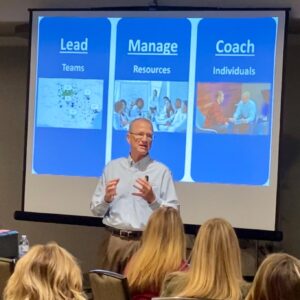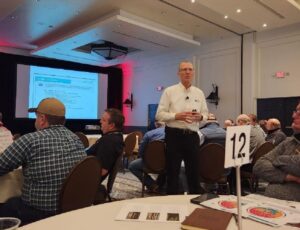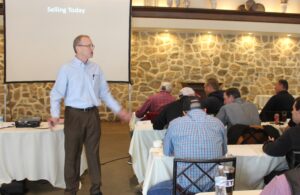I’d Like a Brand-new Feed Mill for Christmas
The old saying “Be careful what you wish for, because you might just get it” comes to mind throughout this adventure in what was to be my second worst day at selling feed. We operated two mills in the area. One, built in the 1950’s and the other in the 1970’s. Originally, one designed to be a grain elevator and the other to produce large runs of hog feed. With the large-scale hog operations gone and the elevator converted to a dairy feed plant and then adapted to make the multitude of retail feeds, we had maxed out the capabilities of these two older feed mills. Several long-term maintenance folks and our plant managers were able to do miracles with the old mills. They not only kept us running but created some unique systems to make textured, fine crumbles, course crumbles, two different size pellets and occasionally a batch of cubes. Through a series of 2-way switches, we were able to ship all these different forms in bags, bulk and 2,000# totes.
Everyone at the locations was in agreement. We needed a new feed mill to replace the old ones and reduce the amount of down time & inefficiencies and to just make life easier. We were running three shifts at both locations and we all felt like production was maxed out. Well, after many years and a lot of research & planning, we got our wish. It was the first brand new factory I was involved in and I thought this would be as easy as putting the key into a brand-new car and turning it on. Just turn the lights on, get some steam to the pellet mill and away we’d go. Let’s just say, it didn’t exactly go that way.
Everything about the new facility was state of the art. We had the best equipment and capabilities of any mill in our company, not to mention versus our competition. We could run bulk textured and blend the products as it went onto the truck. We had two sides of the mill so Ionophores couldn’t mix with horse products. We had two pellet mills. One state of the art & brand new. One, a more standard pellet mill & slightly used. Every function was controlled by computer panels. No more pulling levers, chains or flipping switches.
With excited anticipation, the day came when we flipped the lights on and started to make feed. Our first challenge came in running the old plants with three shifts as the new plant came on line and we worked out the bugs. For the next 4-6 months, we hit one challenge after another. The state of the art pellet mill was rebuilt three times before being completely replaced. The standard pellet mill saved us over and over as we struggled through the launch. Next came the bulk textured load out. For this to work, auger speed is critical and it seemed like we couldn’t get it right. We had a robot bag stacker, which was great. However, it was also great that we had a fence around it when we were calibrating it. “Billy” as it was affectionately named, would get a little wild and send some bags flying during the programming process. Throughout the mill, multiple augers would move pelleted feed from one place to another. Suffice it to say, these augers need to be moving at the same speed. Otherwise, you get bottle necks. When this happens, the overloaded auger kind of just grinds your nice pellets back into a meal. One last challenge we had was around the automation piece to the mill. With everything operating off of panels, when electricity went out, we were completely down. Built in a brand-new business park, the mill had an occasional challenge getting power. At that point, nothing worked, including load out. And “no” despite my recommendation, you can’t just go down to the local hardware store and buy a couple generators to run a plant this size. Nor can you run an extension cord from the nearby beer distributor. Both my ideas were thrown out that day, darn it. Although, it was good to meet our neighboring beer distributor team.
One thing I want to emphasize is that everyone involved had the best of intentions. From the engineers who designed it, to the multiple contractors who built it, to the managers who made hundreds of decisions throughout the construction to the sales team who made the sales projections. A project of this scale just has a lot of moving parts and it takes some time to work the bugs out in the first few months.
Below are a few take away ideas from the experience.
- Be careful what you wish for. Kind of like that old car you see around town that has the bumper sticker that says “At least it’s paid for”. Our old mills had been paid for long ago and could be considered in the cash cow stage of life. The new mill came with a whole set of problems those first 4 months and a whole bunch of depreciation. Sales and budget projections had been made on the project and it was expected that we meet them. That can feel like a big hurdle when your new mill can’t kick out the loads of feed you need. Not saying to never build a new mill, but you really want it to be absolutely necessary. Probably after your cash cow moves to the next stage of the business cycle. I think it’s called the dead horse stage or something along those lines.
- State of the art is great but “proven” state of the art is better. New feed mills aren’t built every day. When they are, a lot of folks get excited and want to try out new state of the art equipment or processes. That’s great, but it needs to be state of the art and not experimental. A lot of engineers are involved and a lot of design and redesign goes on throughout the project. Vendors want to install their latest and greatest equipment. Again, these are all with good intentions. Just make sure they have been tested in the geography that you are in.
- Customer’s want to know why it happened, but most importantly, they want to know when it will be fixed. I’ve mentioned this in past that your customer finds out just how truly valuable you are as a sales person during the crisis situations. That’s exactly what this team did. They got in front of customers, opened bags, looked into feeders, brought back samples, worked with the production team and everyone communicated as much as possible to get through the situation. They were tough times and we certainly lost customers as a result, but I’m certain we lost fewer due to the team stepping up to be proactive during the crisis.
- Sales & budget projections. In order to justify the expense of a new factory, it takes either a big increase in sales or an estimated large expense to fix the old one. To get these increases, the sales team is brought into planning sessions and given the opportunity to provide input on how much more product they could sell with the new mill, new retail location, new service, new whatever. Make sure you are very clear and can deliver on it. It may seem like a long way off till you are actually asked about those projections but, trust me, that day will arrive and you need to deliver. This is not the time to get caught up in the emotions and hype of selling the idea of a new mill. Unless you are comfortable hitting those numbers.
- Capabilities meeting. One thing that really helped us after about a month in action was to bring the sales, admin and production teams together to discuss actual capabilities. We had the capabilities of the old facilities figured out. However, we had conflicting stories on the capabilities of the new mill. Things were different. Tons per hour, minimum run sizes, twice as many loading docks, faster micros system were some of the new factors in the capabilities of the new mill. We held a couple of these meetings over the next 90 days and it helped to reduce the friction and it helped the sales team talk with customers.
As with most crisis situations, in time, we got better and eventually life went back to a normal pace with the occasional issue. We survived the storm with a stronger team. Not thrilled to have gone through it but wiser and definitely proud to have survived the experience.
Unfortunately, there was to be one more day that was worse than this “day”. More on that fun-filled experience later.
To Schedule a Free initial coaching session today, contact me directly at Greg@GregMartinelli.net
For more on Ag Sales Training, Ag Sales Coaching and Leading Ag Sales Teams, go to




